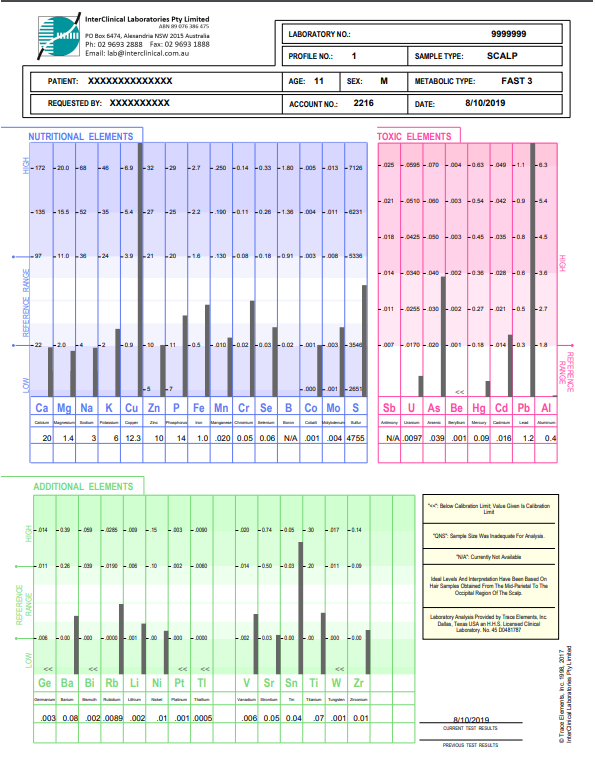HTMA Hair Tissue Mineral Analysis

Hair Tissue Mineral Analysis provides valuable information on existing health conditions.
Further, it helps with early detection and prevention of conditions, as mineral imbalances are often seen before symptoms occur.
Hair Tissue Mineral Analysis (HTMA) is an analytical test that measures the mineral composition of hair. It is a safe and non-invasive test that reflects the level of nutrient and toxic elements in body tissue. It is regarded by integrative doctors, naturopaths and nutritional therapists as one of the most valuable screening tools available in everyday and preventative health care.
Hair is a body tissue made up of mostly dead, keratinized cells fused together. The shaft of the hair is the portion that projects from the skin’s surface. The root of the hair, below the skin’s surface, contains living matrix cells from which the hair grows. Matrix cells depend on the blood supply for nourishment and growth. As they grow and divide, minerals are keratinized into the growing hair shaft, creating a permanent record of metabolic activity and exposure to toxic elements.
Research has shown that hair tissue is useful in indicating nutrient imbalances and exposure to toxic elements. If your health, diet or environment has created a mineral imbalance or toxic mineral excess, it will be recorded in the hair shaft.
Importance of Minerals
Minerals are essential for growth, healing, vitality and wellbeing. They provide structural support in bones and teeth, and maintain the body’s pH, water balance, nerve activity, muscle contractions, energy production and enzyme reactions. They are the basic ‘spark plugs’ of life.
Imbalances and Toxins
Our health and wellbeing may be aggravated by mineral imbalances and toxic metal excesses, aggravating conditions including cardiovascular disease, high cholesterol, high blood pressure, migraines, learning difficulties and hyperactivity in children, to name just a few.
Why Practitioners use Hair Tissue Mineral Analysis
- Identify heavy metals and toxic element burdens and access progress.
- Identify nutritional deficiencies, excesses and imbalances then develop a precise nutritional therapeutic approach
- Ability to monitor health and nutritional balances over time – retest, review and revise the plan.
- Recognition of the sympathetic and parasympathetic responses to metabolic dysfunctions.
- Determining the link between the nutritional, neurological and endocrine systems, as identified by hair mineral patterns.
- Development of a supplement program for specific bio-individual and metabolic types.
- Identification of endocrine interrelationships and their impact upon biochemical and nutritional status; recognition of specific nutritional influences upon the biochemical and endocrine systems.
- Real measurements of nutrient and toxic minerals in parts per million.
What can Hair Tissue Mineral Analysis Reveal?
- MINERAL DEFICIENCIES AND EXCESSES
- HEAVY METAL TOXICITY
- METABOLIC RATE (FAST OR SLOW)
- IMMUNE
- MENTAL HEALTH
- NERVOUS SYSTEM IMBALANCE
- LIVER & KIDNEY STRESS
- DIABETES AND INSULIN RESISTANCE
- ENERGY LEVELS & FATIGUE
- CARDIOVASCULAR HEALTH
- ADRENAL & THYROID FUNCTION
- SPORTS ENDURANCE & RECOVERY
Hair Tissue Mineral Analysis provides clinical data missed by standard blood, urine and stool testing.
It provides important information to help you get your health back on-track and maintain wellness in all stages of life!
Why Test for Minerals?
Minerals are essential for growth, healing, vitality and wellbeing. They provide structural support in bones and teeth, and maintain the body’s pH, water balance, nerve activity, muscle contractions, energy production and enzyme reactions. They are the basic ‘spark plugs’ of life.
Ideally we should get all the minerals we need from a balanced diet. Unfortunately today this is rarely possible. Modern farming techniques, fertilisers and depleted soils reduce the mineral content of foods. Environmental pollutants, chemical food additives, pharmaceutical medicines and stressful lifestyles also have a detrimental effect on our nutritional status.
Many health conditions are aggravated by mineral imbalances and toxic metal excesses, including cardiovascular disease, high cholesterol, high blood pressure, migraines, learning difficulties and hyperactivity in children, to name just a few.
Consequently, we need to test and monitor our nutritional status more than ever.
Advantages of HTMA
- Safe, scientific, non-invasive pathology test.
- Reliable data on up to 35 nutrient and toxic minerals, and over 25 important mineral ratios.
- Discovery of nutrient mineral imbalances or toxic mineral excesses that may be affecting your health.
- Valuable health information often not revealed in standard blood and urine tests.
- Unlike blood, hair is less susceptible to the homeostatic mechanisms that quickly affect trace elements levels.
- Long term deviations of mineral retention or losses are more easily detected in hair that blood. Hair provides a record of past as well as present trace element levels, ie biological activity.
- Personalised interpretive test reports that assess your current mineral status, highlight areas of concern and recommend dietary changes and supplements for improved health and wellbeing. NB: Supplement recommendation only available on Practitioner Report.
10 Reasons to have a Hair Tissue Mineral Analysis
- Hair specimens can be collected more quickly and easily than blood, urine, or any other tissue, using a non-invasive method.
- Hair analysis is more cost-effective than mineral testing through other means.
- Unlike blood, hair is less susceptible to the homeostatic mechanisms that quickly affect trace element levels.
- Long-term deviations of mineral retention or losses are more easily detected in hair than blood.
- Hair testing reveals key information about your level of metabolic activity.
- Concentrations of most elements in the hair are significantly higher than found in the blood and other tissues.
- Hair provides a record of past as well as present trace element levels, i.e. biological activity.
- Hair provides information of substances entering the hair from the blood serum as well as from external sources.
- Hair is invaluable in the assessment of toxic metal levels.
- Hair testing measures mineral imbalances that can directly affect related vitamin activity.
The Gold Standard in trace element pathology.
Our Hair Tissue Mineral Analysis Report measures minerals in parts per millions with the highest level of accuracy and reproducibility. The analysis and recommendations are comprehensive and informative, with expertise that comes from testing over 1.5 million samples. The interpretive report provides a detailed nutritional health discussion of test results commenting on mineral balances, ratios, metabolic type, trends, dietary suggestions, potential food allergens, areas of concern (with possible contributing factors) and supplemental recommendations.
Which report should I choose?
Profile 1 Results Only Report This report provides the graphic result only, with metabolic type and up to 37 minerals and 27 ratios. Mineral relationships are as important, if not more so than the individual mineral levels. These can highlight mineral disturbances.
Profile 2 Interpretive Report (recommended report) There are over 4,000 calculations and comparisons done to produce this comprehensive report. This report provides the graphic result with metabolic type, plus an in-depth explanation of the nutritional and toxic mineral levels and ratios. Ratios are more important than the individual mineral levels, as these reflect any disturbance in the critical balance of minerals. When this critical balance is disturbed adverse health trends can arise. These trends are listed and clearly explained in relation to the mineral imbalance. The report provides nutritional supplement recommendations, extensive dietary suggestions and nutritional contraindications.
Profile 3 Comparative Report This report provides a comparison between the nutritional and toxic mineral levels and ratios and health tendencies from the last report and is for follow-up and re-evaluation testing.
Test result available 10-15 days from the date we receive sample and payment.
ELEMENT PANELS
Elements routinely tested in Profiles 1, 2 and 3
Calcium, Magnesium, Sodium, Potassium, Copper, Zinc, Phosphorus, Iron, Manganese, Chromium, Selenium, Cobalt, Molybdenum, Sulfur, Uranium, Arsenic, Beryllium, Mercury, Cadmium, Lead, Aluminum, Germanium, Barium, Bismuth, Rubidium, Lithium, Nickel, Platinum, Thallium, Vanadium, Strontium, Tin, Titanium, Tungsten, Zirconium. (Boron and Antimony at extra charge)
Elements routinely tested in Profiles 10 and 16
Calcium, Magnesium, Sodium, Potassium, Copper, Zinc, Phosphorus, Iron, Manganese, Chromium, Selenium, Cobalt, Molybdenum, Sulfur, Uranium, Arsenic, Beryllium, Mercury, Cadmium, Lead, Aluminum, Germanium, Barium, Lithium, Nickel, Platinum, Vanadium, Strontium, Tin, Tungsten, Zirconium. (Boron and Antimony at extra charge)
If you are interested in having a HTMA - please contact me and we can discuss what your needs are and the report to suit you at this time.
